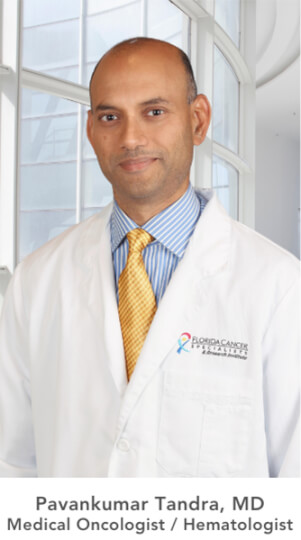Study shows women with low-risk breast cancer could skip postop radiation
Great strides have been made in the management of breast cancer over the years. Breast-conserving therapy (BCT) is now an option for certain patients with low-risk breast cancers. BCT involves surgery to remove only the cancerous area and some surrounding normal tissue (lumpectomy) as an alternative to radical mastectomies that remove the entire breast. It is typically followed by radiation therapy to the remaining breast tissue. A recently published study in the New England Journal of Medicine provides further data to support that certain female patients over age 65 can achieve positive outcomes without postoperative radiation.
Gail Lynn Shaw Wright, MD, FACP, FCCP and Pavankumar Tandra, MD, Florida Cancer Specialists & Research Institute Board-certified medical oncologists who specialize in the treatment of breast cancer, share their comments on the findings of the study.
Gail Wright, MD:
 Ian H. Kunkler, et.al. published the 10-year outcomes of the PRIME II trial in the February 16, 2023 issue of the New England Journal of Medicine. This trial looked at women 65 years of age or older who had hormone-receptor-positive breast cancer less than or equal to 3 cm with no spread to lymph nodes treated with breast conserving surgery with clear margins and adjuvant (post-operative) endocrine therapy.
Ian H. Kunkler, et.al. published the 10-year outcomes of the PRIME II trial in the February 16, 2023 issue of the New England Journal of Medicine. This trial looked at women 65 years of age or older who had hormone-receptor-positive breast cancer less than or equal to 3 cm with no spread to lymph nodes treated with breast conserving surgery with clear margins and adjuvant (post-operative) endocrine therapy.
This trial is looking at a very specifically defined subset of breast cancer patients who have very favorable early-stage breast cancer with positive expression of hormone receptors, no spread to lymph nodes, measuring no greater than 3 cm, excised with clear margins and who were treated with postoperative endocrine therapy. Patients were randomly assigned to receive whole breast irradiation versus no radiation.
Local breast cancer recurrence in the breast within 10 years was 9.5% in the group that did not get postoperative radiation and 0.9% in the group treated with postoperative radiation. Local recurrence was 10.4 times more likely in the group that was not treated with radiation. However, overall survival at 10 years was nearly identical in the two groups at 80.8% without radiation and 80.7% with radiation.
The study does support consideration of omitting postoperative radiation in patients with breast cancer who meet the criteria of the group studied in this trial who are willing to take the postoperative endocrine therapy, without compromising their overall survival. However, it does come with a greater than 10-fold risk of a local recurrence in the breast, which would require further surgery and radiation at the time of this local recurrence. The study does support omitting radiation in appropriate patients after a thorough discussion of the pros and cons.
Pavan Tandra, MD:
 PRIME II, and CALGB 9343 are the largest well conducted randomized controlled studies we have thus far which answers this important question of who can safely avoid radiation in early-stage breast cancer without affecting their overall survival. We must be careful in the consultation rooms when we address this important question of omitting radiation for our cancer patients in the community.
PRIME II, and CALGB 9343 are the largest well conducted randomized controlled studies we have thus far which answers this important question of who can safely avoid radiation in early-stage breast cancer without affecting their overall survival. We must be careful in the consultation rooms when we address this important question of omitting radiation for our cancer patients in the community.
Definitely “some” patients can avoid radiation safely without affecting overall survival. PRIME II reported its 10 years survival data in the NEJM Journal. The investigators of this study selected patients who had lumpectomy with at least 1 millimeter margins clearance, and are above 65 years of age, with hormone receptor positive lymph node negative breast cancers of size less than three centimeters. The study concluded that these carefully selected “low” risk population can omit radiation if they are agreeable to take five years of “estrogen blocking” pill. I believe, the last sentence is the key to making decisions in these patients. Estrogen blocking pills have many side effects and not all women are able to maintain compliance for five long years.
I agree with the authors about the applicability of these results to clinical practice will be influenced by the balance of the risks and benefits of radiation as compared with those of endocrine therapy.
Link to NEJM Study: https://www.nejm.org/doi/full/10.1056/NEJMe2216133
Facts About Breast Cancer: Breast cancer is the most commonly diagnosed cancer among American women, except for skin cancers. The American Cancer Society estimates that 12% of American women will develop breast cancer by age 85. Most breast cancers are found in women age 50 and older. Although rare, men get breast cancer, too — nearly 3,000 American men are estimated to receive a breast cancer diagnosis this year. There are many subtypes of breast cancer, and each must be treated differently.
